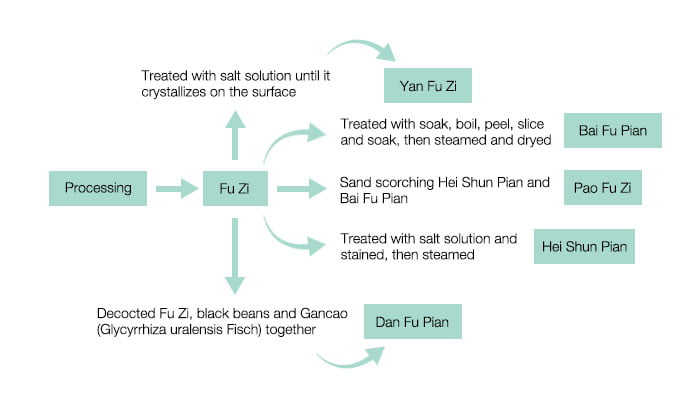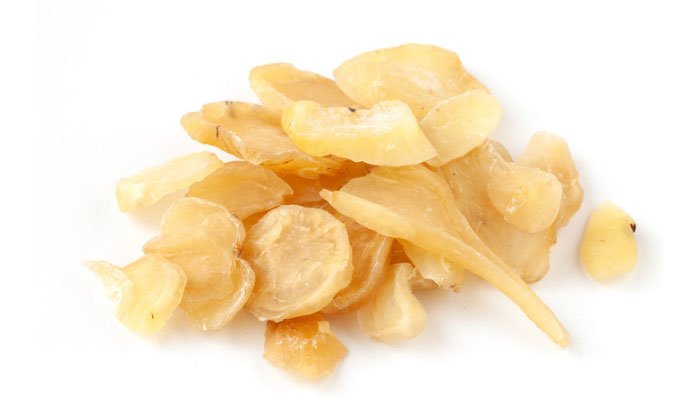What Is Fu Zi
Fu Zi commonly known as Radix Aconiti Lateralis Preparata is the processed lateral root of Aconitum carmichaelii Debx, which is a perennial herb belonging to the family Ranunculaceae. It is a famous Chinese herbal medicine, which first appeared in <Shennong Ben Cao Jing> in the late Western Han Dynasty (around 100 BCE).
There are about 330 species of Aconitum, which are mainly distributed in the humid regions of the temperate mountains of the northern hemisphere. All species of this genus are poisonous, and they contain toxic alkaloids, such as aconitine. Some of these species are common medicinal plants, such as Aconitum carmichaelii Debx.
Aconitum carmichaelii Debx commonly known as Wu Tou, Chinese aconite, Carmichael’s monkshood, or Chinese wolfsbane is a flowering plant. They often grow in mountain grass slopes or shrubs at an altitude of 100 to 2,200 meters. They are mainly distributed in China and Vietnam.
From late June to early August, people gather the lateral roots of Aconitum carmichaelii Debx, remove their mother roots, fibrous roots, and impurities, wash them with water, make them into Yan Fu Zi, Hei Shun Pian, Bai Fu Pian, Dan Fu Pian, and Pao Fu Zi.

Fu Zi contains n-deethylaconine, aconifine, aldohypaconitine, oxonitine, hypaconine, mesaconine, 8-methoxymesaconine, 8-methoxyhypaconine, Hukbusine A, hypaconitine, mesaconitine, beiwutine, isodelphinine, lipomesaconitine, lipohypaconitine, 8-oet-14-benzoylmesaconitine, hukbusine B, karacoline, senbusine A~C, neoline, fuziline, talatizamine, chasmanine, karakanine, foresticine, isotalatizidine, deoxyaconine, benzoylmesaconine, monoacetyltalizamine, benzoylaconine, benzoylhypaconine, 14-O-cinnamoylneoline, 14-O-anisoylneoline, 14-O-veratroylneoline, 14-O-acetyneoline, condelphine, 14-acetylkarakoline, neojiangyouaconitine, crassicauline A, deoxyaconitine, aconitine, lipoaconitine, lipodeoxyaconitine, lipo-14-O-anisoylbikhaconine, lipoforesaconitine, foresaconitine, lipoyunanaconitine, yunaconitine, 8-O-ethylyunaconitine, 8-O-cinnamoylneoline, aconine, hytigenine, vitrinine, napperine, photretinine, taprophine, salsolinol, fuzitine, yokonoside, higenamine, 6′-O-acetylliquiritin, liquiritigenin, isoliquiritigenin, liquiritin, saponins, ceramides, uracil, fuzinoside, sesamin, episesamin, isolariciresinol, sterols, organic acids, proteins, polysaccharides, amino acids and some trace elements.
Generally, the grayish-brown Yan Fu Zi with salt efflorescence on the surface is preferred. Chewing good quality Yan Fu Zi will make your tongue feel salty and numb. The dark-brown Hei Shun Pian with a dark yellow, lustrous, translucent, and oily cross-section and a slight smell is preferred. The yellowish-white Bai Fu Pian with a translucent and oily cross-section and a slight smell is preferred. The solid Dan Fu Pian with a brown and translucent cross-section is preferred. The crispy and yellow-brown Pao Fu Zi is preferred.
According to the Chinese Pharmacopoeia, the medicinal nature of Fu Zi is extremely hot, with a pungent and sweet taste. It has certain pharmacological effects on the pathological changes of the heart, kidney, and spleen meridians.
In traditional Chinese medicine, it is often used to recuperate depleted yang and rescue patients from collapse, replenish fire to invigorate yang, eliminate cold to stop the pain, and treat the syndrome of yang-exhaustion, impotence, spermatorrhoea, sterility due to uterine cold, cold pain in waist and knees, frequent night urination, cold pain of stomach and abdomen, vomit, loose stool, palpitation, shortness of breath, chest discomfort, cardialgia, bronchitis, depression, epilepsy, dementia, arrhythmia, myocardial infarction, heart failure, chronic cardiac insufficiency, shock, acute coronary syndrome, coronary heart disease, rheumatic heart disease, rheumatoid arthritis, ankylosing spondylitis, diabetes mellitus, chronic renal failure, severe sepsis, primary hypothyroidism.
There are more than 100 kinds of classic traditional Chinese medicine prescriptions containing it, such as Si Ni Tang, Fu Zi Li Zhong Tang, and Ma Huang Fu Zi Tang.
Benefits
- Anti-inflammation, inhibiting xylene-induced swelling of the mouse ear.
- Recuperating depleted Yang and rescuing patients from collapse, treating sweating with fatigue, deadly cold hand and foot, and fainting pulse caused by aeipathia, a decline of yang-qi, excessive yin-cold in the interior, or profuse sweating, vomiting, or diarrhea.
- Treating cold limbs, aversion to cold with curling up, vomiting and diarrhea, abdominal pain, deep, slow, and weak pulse or loss of pulse caused by direct attack of exogenous cold disease on three yin channels.
- Replenishing kidney yang, treating impotence, spermatorrhoea, sterility due to uterine cold, cold pain in waist and knees, frequent night urination caused by insufficiency of the kidney yang, and decline of vital gate fire.
- Replenishing spleen yang, treating cold pain of stomach and abdomen, vomit, loose stool caused by insufficiency of both the spleen and the kidney, and superabundance of cold-dampness in the interior.
- Treating difficulty in micturition, edema caused by insufficiency of both the spleen and the kidney, and internal retention of water-dampness.
- Replenishing heart yang, treating a deficiency of heart-yang, palpitation, shortness of breath, chest discomfort, and cardialgia.
- Warming and activating meridians, treating arthralgia caused by wind-cold-damp.
- Its alkaloids have analgesic properties and reduce the number of writhing in mice induced by acetic acid [1].
- Its water extract improves testosterone propionate-induced benign prostatic hyperplasia in rats via suppressing 5-alpha reductase and inducing prostate cell apoptosis [2].
- Its water-soluble polysaccharide protects against the oxidized low-density lipoprotein-induced calcification of human vascular smooth muscle cells by increasing autophagic activity [3].
- Its water-soluble polysaccharide has antioxidant activity and immunomodulatory activity. It promotes macrophage phagocytosis and increases the secretion of macrophage-derived biological factors in RAW 264.7 cells [4].
- Its water-soluble polysaccharide promotes hippocampal neurogenesis, reduces immobility in the forced swim test, and latency in the novelty suppressed-feeding test. It has an antidepressant effect [5].
- Its total alkaloids, water-soluble alkaloids, and polysaccharides have cardiotonic effects. Its specific mechanism is manifested as inhibiting myocardial fibrosis, apoptosis and autophagy, improving mitochondrial energy metabolism, involving RAAS system, PI3K/AKT, JAK/STAT, AMPK/mTOR signaling pathways, etc [6].
- Inhibiting the growth of mouse S180 and H22 tumor-bearing tumors and the proliferation of gastric cancer SGC-7901 cells, and inducing apoptosis of B lymphoma Raji cells.
- Studies have found that its polysaccharides have antioxidant activity and protect against hydrogen peroxide-damaged NRK-52E cells and cisplatin-induced acute kidney injury in mice [7].
- Studies have found that fuziline can reduce ISO-induced myocardial injury in vitro and in vivo by inhibiting ROS-triggered ER stress via the PERK/eIF2α/ATF4/Chop pathway [8].
Combinations
- It can be used in combination with Gan Jiang (Dried Ginger) and Zhi Gan Cao (Radix Glycyrrhizae Preparata) to treat sweating with fatigue, deadly cold hand and foot, and fainting pulse caused by aeipathia, a decline of yang-qi, excessive yin-cold in the interior, or profuse sweating, vomiting, or diarrhea.
- It can be used in combination with Gan Jiang (Dried Ginger), Rou Gui (Cinnamomi Cortex), and Ren Shen (Radix et Rhizoma Ginseng) to treat cold limbs, aversion to cold with curling up, vomiting and diarrhea, abdominal pain, deep, slow and weak pulse or loss of pulse caused by direct attack of exogenous cold disease on three yin channels.
- It can be used in combination with Rou Gui (Cinnamomi Cortex), Shan Zhu Yu (Fructus Corni), Shu Di Huang (Processed Rehmannia Root), etc. to treat impotence, spermatorrhoea, sterility due to uterine cold, cold pain in waist and knees, frequent night urination caused by insufficiency of the kidney yang and decline of vital gate fire.
- It can be used in combination with Ren Shen (Radix et Rhizoma Ginseng), Bai Zhu (Rhizoma Atractylodis Macrocephalae), and Gan Jiang (Dried Ginger) to treat cold pain of stomach and abdomen, vomit, loose stool caused by insufficiency of both the spleen and the kidney, and superabundance of cold-dampness in the interior.
- It can be used in combination with Fu Ling (Poria) and Bai Zhu (Rhizoma Atractylodis Macrocephalae) to treat difficulty in micturition, edema caused by insufficiency of both the spleen and the kidney, and internal retention of water-dampness.
- It can be used in combination with Ren Shen (Radix et Rhizoma Ginseng) and Gui Zhi (Ramulus Cinnamomi) to treat deficiency of heart-yang, palpitation, shortness of breath, chest discomfort, and cardialgia.
- It can be used in combination with Gui Zhi (Ramulus Cinnamomi), Bai Zhu (Rhizoma Atractylodis Macrocephalae), and Gan Cao (Licorice Root) to treat severe pain due to cold arthralgia.
Side Effects
- Fu Zi contains some toxic alkaloids, such as aconitine, mesaconitine, and so on. In clinical practice, there are many cases of poisoning or death due to improper use.
- The side effects of Fu Zi may include numbness of the whole body, accompanied by lip distortion, salivation, tetany, and other symptoms, as well as chest tightness, palpitation, dizziness, and burning sensation of the throat, esophagus, and stomach. Furthermore, it may also present with restlessness, nausea and vomiting, diarrhea, rapid pulse, fall in blood pressure, dyspnea, hypothermia, dysphonia, and incontinence of urine and feces. In extreme cases, severe convulsions, dilated pupils, coma, respiratory arrest, circulatory disorders, and respiratory failure can occur resulting in death [9].
Precautions and Warnings
- The dosage of Fu Zi should be controlled at 3-15g.
- It can be made into decoctions, pills, medicinal liquors, or grounds for external use.
- When making its decoction, it is recommended to fry it first and cook it for a long time (Decoction of Fu Zi for a long time can reduce its toxicity and reduce adverse reactions after taking the medicine).
- The unprocessed Fu Zi is recommended for external use, and the processed Fu Zi is recommended for internal use.
- People who are allergic to Fu Zi should not take it.
- It should not be used together with Ban Xia (Pinellia Rhizome), Gua Lou (Fructus Trichosanthis), Gua Lou Ren (Semen Trichosanthis), Tian Hua Fen (Radix Trichosanthis), Chuan Bei Mu (Fritillaria Cirrhosa), Zhe Bei Mu (Fritillariae Thunbergii Bulbus), Ping Bei Mu (Fritillariae Ussuriensis Bulbus), Yi Bei Mu (Fritillariae Pallidiflorae Bulbus), Hu Bei Bei Mu (Fritillariae Hupehensis Bulbus), Bai Lian (Ampelopsis Radix), or Bai Ji (Rhizoma Bletillae).
- It should not be taken at the same time as digitalis, potassium iodide, vitamin C, niacin tablets, glutamate tablets, streptomycin, or kanamycin.
- Patients with syndromes of excess heat should not take it.
- Patients with hyperactivity of yang due to yin deficiency, or insufficiency of body fluid and blood should not take it.
- Pregnant women should not take it.
- Lactating women, children, and the elderly and infirm should be taken under the guidance of a physician.
